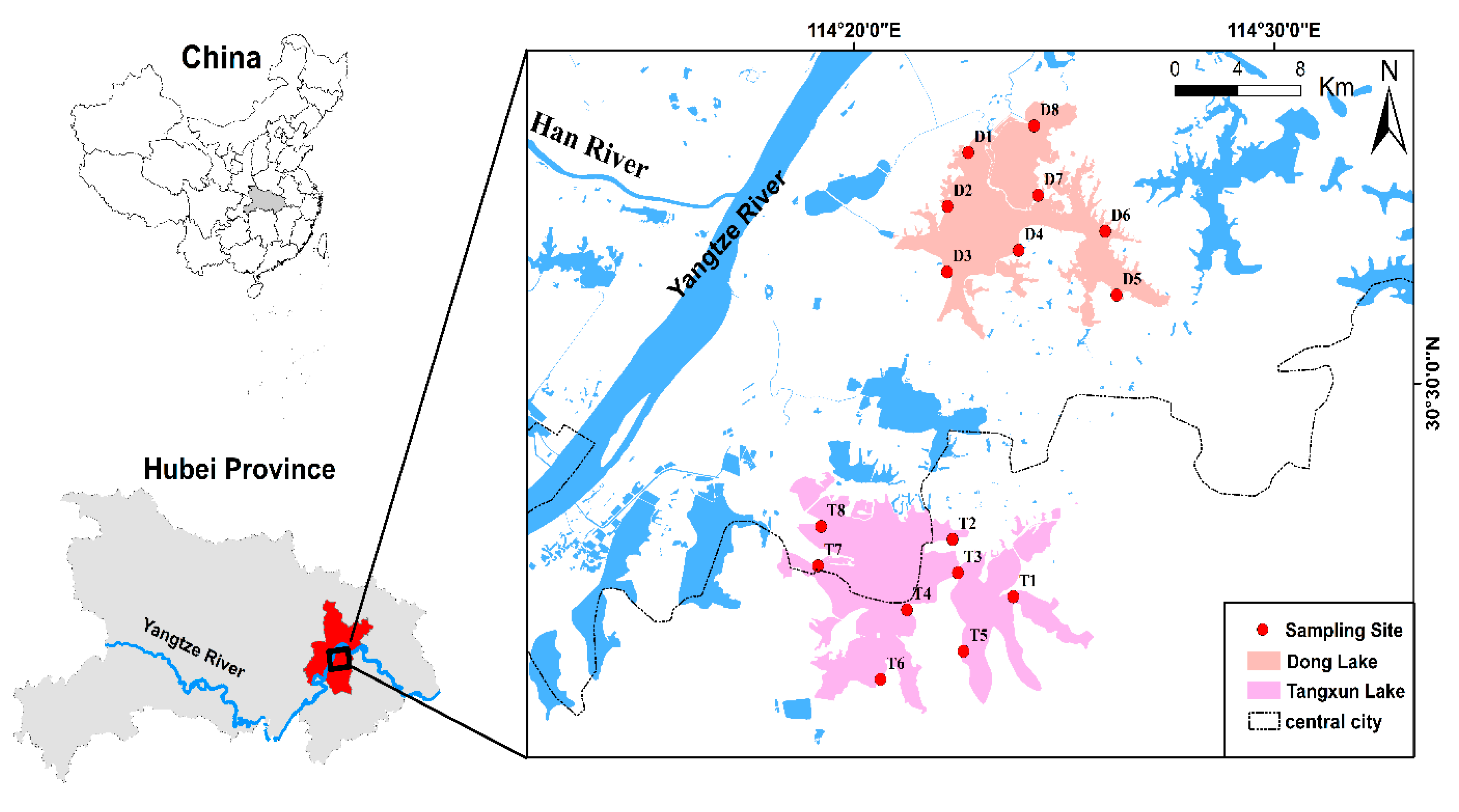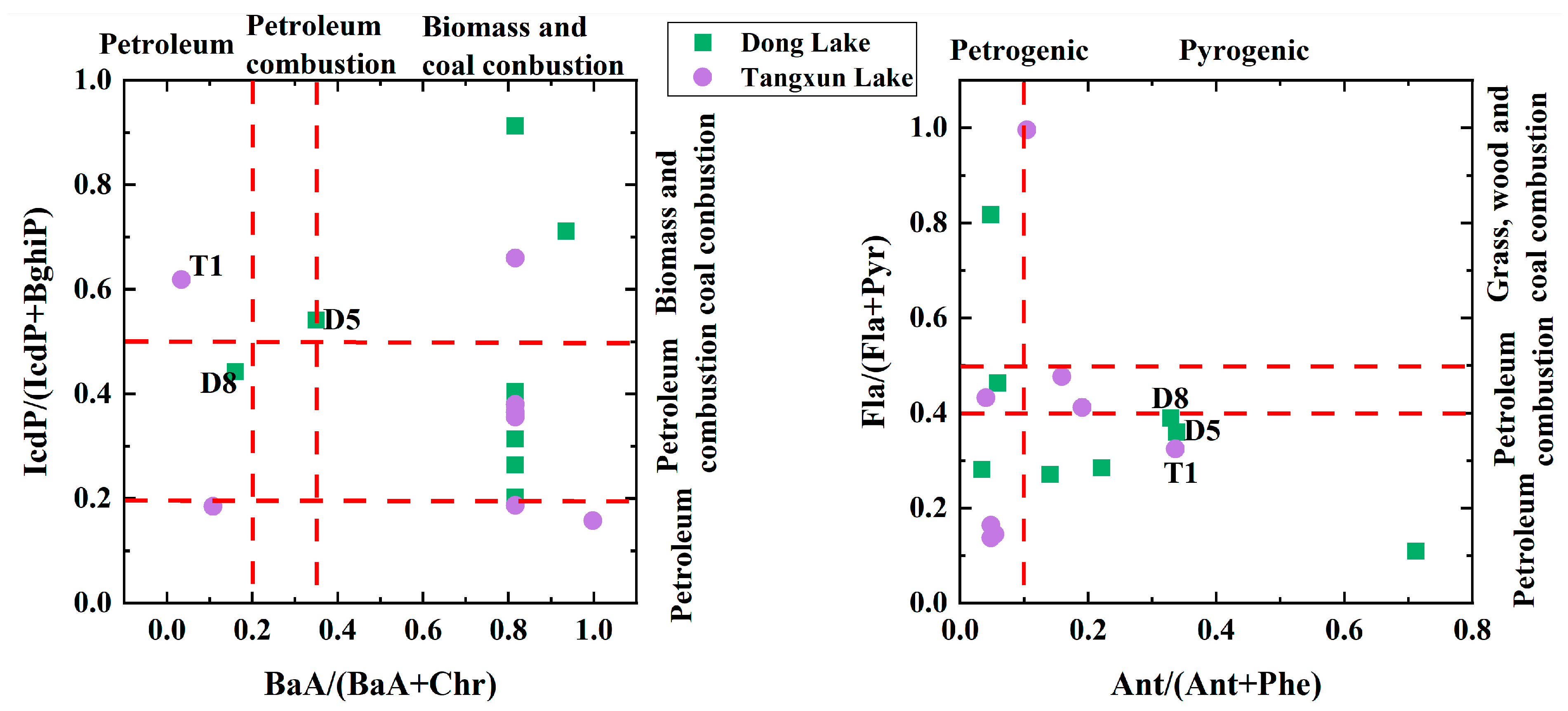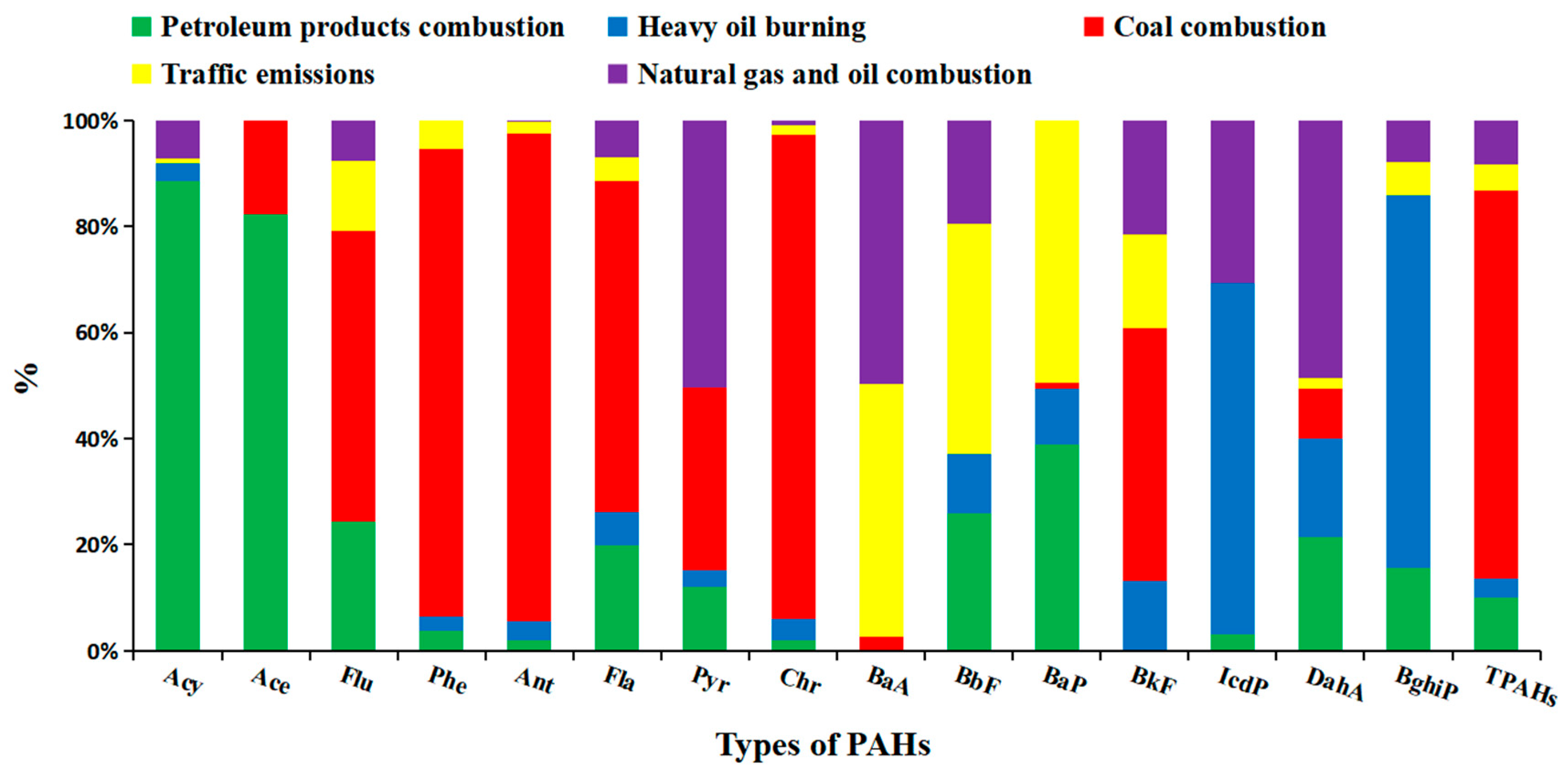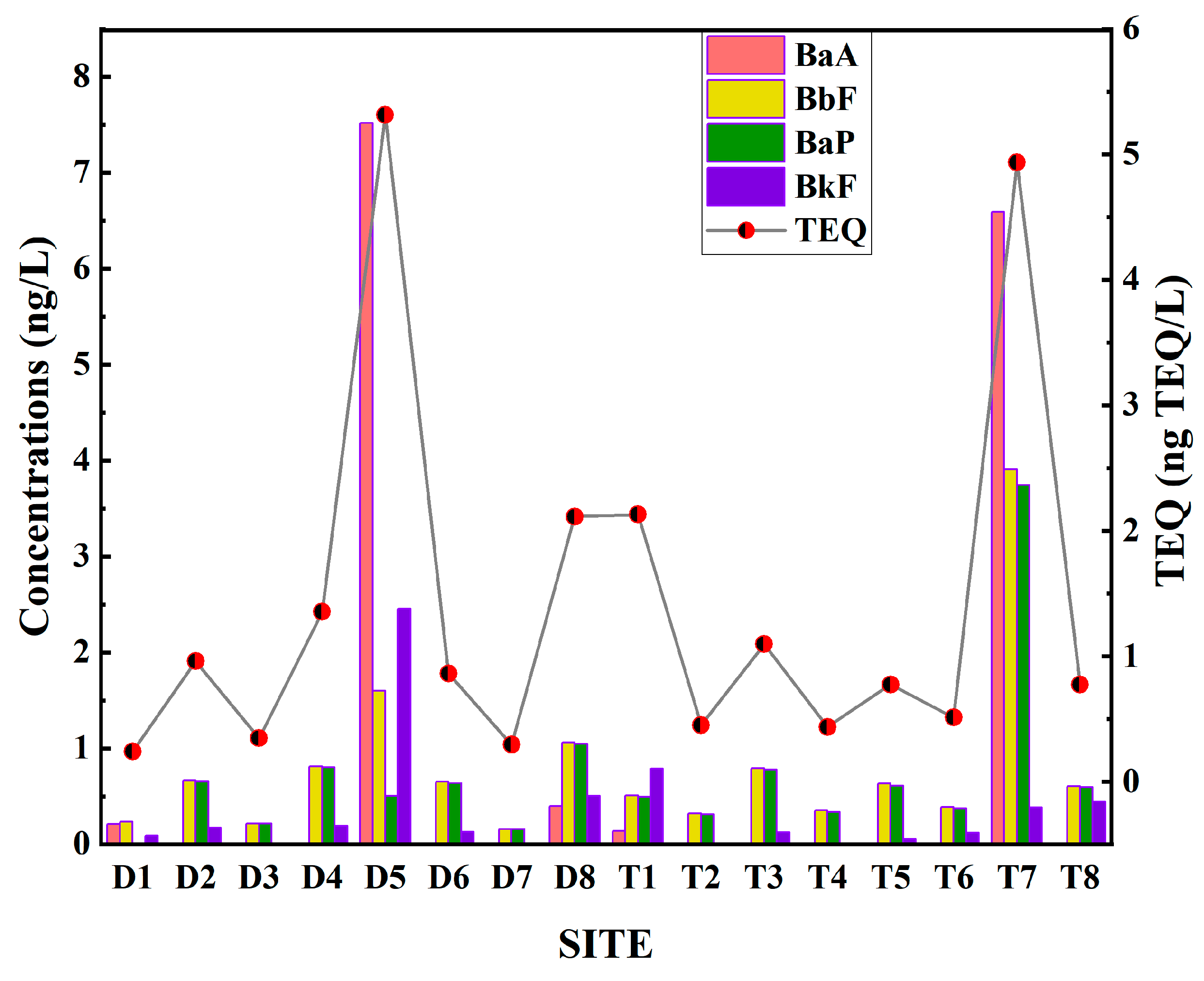Polycyclic Aromatic Hydrocarbons in the Water Bodies of Dong Lake and Tangxun Lake, China: Spatial Distribution, Potential Sources and Risk Assessment
Abstract
1. Introduction
2. Methods
2.1. Study Area and Sampling
2.1.1. Study Area
2.1.2. Sampling
2.2. Chemical and Instrumental Analysis
3. Results and Discussion
3.1. Concentration and Spatial Distribution
3.2. Source Identification
3.3. Ecological and Human Risk of PAHs
4. Conclusions
Author Contributions
Funding
Data Availability Statement
Conflicts of Interest
References
- Celik-Saglam, I.; Balcik, C.; Cetin, B. Concentrations, Sources, and Risk Assessment of Polycyclic Aromatic Hydrocarbons (PAHs) in Black, Green and Fruit Flavored Tea in Turkey. J. Food Compos. Anal. 2022, 109, 104504. [Google Scholar] [CrossRef]
- Świt, P.; Orzeł, J.; Maślanka, S. Investigation of the Origin and Concentration of Polycyclic Aromatic Hydrocarbon with Improved Accuracy by the Use of a Multi-Component Integrated Calibration Method in the Katowice Region, Poland. J. Hazard. Mater. 2023, 448, 130871. [Google Scholar] [CrossRef]
- Zhi, H.; Zhao, Z.; Zhang, L. The Fate of Polycyclic Aromatic Hydrocarbons (PAHs) and Organochlorine Pesticides (OCPs) in Water from Poyang Lake, the Largest Freshwater Lake in China. Chemosphere 2015, 119, 1134–1140. [Google Scholar] [CrossRef] [PubMed]
- Men, B.; He, M.; Tan, L.; Lin, C.; Quan, X. Distributions of Polycyclic Aromatic Hydrocarbons in the Daliao River Estuary of Liaodong Bay, Bohai Sea (China). Mar. Pollut. Bull. 2009, 58, 818–826. [Google Scholar] [CrossRef] [PubMed]
- Wang, X.; Xu, H.; Zhou, Y.; Wu, C.; Kanchanopas-Barnette, P. Distribution and Source Apportionment of Polycyclic Aromatic Hydrocarbons in Surface Sediments from Zhoushan Archipelago and Xiangshan Harbor, East China Sea. Mar. Pollut. Bull. 2015, 101, 895–902. [Google Scholar] [CrossRef]
- Yu, W.; Liu, R.; Xu, F.; Shen, Z. Environmental Risk Assessments and Spatial Variations of Polycyclic Aromatic Hydrocarbons in Surface Sediments in Yangtze River Estuary, China. Mar. Pollut. Bull. 2015, 100, 507–515. [Google Scholar] [CrossRef]
- Yan, J.; Liu, J.; Shi, X.; You, X.; Cao, Z. Polycyclic Aromatic Hydrocarbons (PAHs) in Water from Three Estuaries of China: Distribution, Seasonal Variations and Ecological Risk Assessment. Mar. Pollut. Bull. 2016, 109, 471–479. [Google Scholar] [CrossRef] [PubMed]
- Zhang, Y.; Tao, S. Global Atmospheric Emission Inventory of Polycyclic Aromatic Hydrocarbons (PAHs) for 2004. Atmos. Environ. 2009, 43, 812–819. [Google Scholar] [CrossRef]
- Yang, J.; Yang, Y.; Chen, R.-S.; Meng, X.-Z.; Xu, J.; Qadeer, A.; Liu, M. Modeling and Evaluating Spatial Variation of Polycyclic Aromatic Hydrocarbons in Urban Lake Surface Sediments in Shanghai. Environ. Pollut. 2018, 235, 1–10. [Google Scholar] [CrossRef]
- Zhang, J.; Qu, C.; Qi, S.; Cao, J.; Zhan, C.; Xing, X.; Xiao, Y.; Zheng, J.; Xiao, W. Polycyclic Aromatic Hydrocarbons (PAHs) in Atmospheric Dustfall from the Industrial Corridor in Hubei Province, Central China. Environ. Geochem. Health 2015, 37, 891–903. [Google Scholar] [CrossRef]
- Arowojolu, I.M.; Tongu, S.M.; Itodo, A.U.; Sodre, F.F.; Kyenge, B.A.; Nwankwo, R.C. Investigation of Sources, Ecological and Health Risks of Sedimentary Polycyclic Aromatic Hydrocarbons in River Benue, Nigeria. Environ. Technol. Innov. 2021, 22, 101457. [Google Scholar] [CrossRef]
- Zhang, Z.; Li, J.; Luo, X.; Li, C.; Zhang, L. Urban Lake Spatial Openness and Relationship with Neighboring Land Prices: Exploratory Geovisual Analytics for Essential Policy Insights. Land Use Policy 2020, 92, 104479. [Google Scholar] [CrossRef]
- Chen, S.; He, H.; Zong, R.; Liu, K.; Miao, Y.; Yan, M.; Xu, L. Geographical Patterns of Algal Communities Associated with Different Urban Lakes in China. Int. J. Environ. Res. Public Health 2020, 17, 1009. [Google Scholar] [CrossRef]
- Huser, B.J.; Futter, M.; Lee, J.T.; Perniel, M. In-Lake Measures for Phosphorus Control: The Most Feasible and Cost-Effective Solution for Long-Term Management of Water Quality in Urban Lakes. Water Res. 2016, 97, 142–152. [Google Scholar] [CrossRef] [PubMed]
- Yang, D.; Qi, S.; Zhang, Y.; Xing, X.; Liu, H.; Qu, C.; Liu, J.; Li, F. Levels, Sources and Potential Risks of Polycyclic Aromatic Hydrocarbons (PAHs) in Multimedia Environment along the Jinjiang River Mainstream to Quanzhou Bay, China. Mar. Pollut. Bull. 2013, 76, 298–306. [Google Scholar] [CrossRef] [PubMed]
- Peng, C.; Chen, W.; Liao, X.; Wang, M.; Ouyang, Z.; Jiao, W.; Bai, Y. Polycyclic Aromatic Hydrocarbons in Urban Soils of Beijing: Status, Sources, Distribution and Potential Risk. Environ. Pollut. 2011, 159, 802–808. [Google Scholar] [CrossRef]
- Shi, M.; Li, R.; Xu, A.; Su, Y.; Hu, T.; Mao, Y.; Qi, S.; Xing, X. Huge Quantities of Microplastics Are “Hidden” in the Sediment of China’s Largest Urban Lake—Tangxun Lake. Environ. Pollut. 2022, 307, 119500. [Google Scholar] [CrossRef]
- Fernandes, M.B.; Sicre, M.-A.; Boireau, A.; Tronczynski’, J. Polyaromatic Hydrocarbon (PAH) Distributions in the Seine River and Its Estuary. Mar. Pollut. Bull. 1997, 34, 857–867. [Google Scholar] [CrossRef]
- Patrolecco, L.; Ademollo, N.; Capri, S.; Pagnotta, R.; Polesello, S. Occurrence of Priority Hazardous PAHs in Water, Suspended Particulate Matter, Sediment and Common Eels (Anguilla Anguilla) in the Urban Stretch of the River Tiber (Italy). Chemosphere 2010, 81, 1386–1392. [Google Scholar] [CrossRef]
- Gigliotti, C.L.; Brunciak, P.A.; Dachs, J.; Glenn, T.R.; Nelson, E.D.; Totten, L.A.; Eisenreich, S.J. Air-Water Exchange of Polycyclic Aromatic Hydrocarbons in the New York-New Jersey, USA, Harbor Estuary. Environ. Toxicol. Chem. 2002, 21, 235–244. [Google Scholar] [CrossRef]
- Chen, Y.; Song, R.; Li, P.; Wang, Y.; Tan, Y.; Ma, Y.; Yang, L.; Wu, L.; Du, Z.; Qi, X.; et al. Spatiotemporal Distribution, Sources Apportionment and Ecological Risks of PAHs: A Study in the Wuhan Section of the Yangtze River. Environ. Geochem. Health 2023, 250, 695–707. [Google Scholar] [CrossRef]
- Wang, L.; Yang, Z.; Niu, J.; Wang, J. Characterization, Ecological Risk Assessment and Source Diagnostics of Polycyclic Aromatic Hydrocarbons in Water Column of the Yellow River Delta, One of the Most Plenty Biodiversity Zones in the World. J. Hazard. Mater. 2009, 169, 460–465. [Google Scholar] [CrossRef] [PubMed]
- Li, M.; Shi, M.; Hu, T.; Liu, W.; Mao, Y.; Yu, Y.; Yu, H.; Xu, A.; Yang, W.; Xing, X.; et al. Geochemical Characteristics and Behaviors of Polycyclic Aromatic Hydrocarbons (PAHs) in Soil, Water, and Sediment near a Typical Nonferrous Smelter. J. Soils Sediments 2023, 23, 2258–2272. [Google Scholar] [CrossRef]
- Zhang, Z.L.; Hong, H.S.; Zhou, J.L.; Huang, J.; Yu, G. Fate and Assessment of Persistent Organic Pollutants in Water and Sediment from Minjiang River Estuary, Southeast China. Chemosphere 2003, 52, 1423–1430. [Google Scholar] [CrossRef]
- Wang, W.; Huang, M.J.; Kang, Y.; Wang, H.; Leung, A.O.W.; Cheung, K.C.; Wong, M.H. Polycyclic Aromatic Hydrocarbons (PAHs) in Urban Surface Dust of Guangzhou, China: Status, Sources and Human Health Risk Assessment. Sci. Total Environ. 2011, 409, 4519–4527. [Google Scholar] [CrossRef] [PubMed]
- Wang, Z.; Qu, C.; Zhang, J.; Zhi, L.; Tang, T.; Yao, H.; Li, W.; Shi, C.; Qi, S. Constructing Model-Averaging Species Sensitivity Distributions of Phenanthrene Based on Reproductive Fitness: Implications for Assessing Ecological Risk in Urban Watershed. J. Hazard. Mater. 2023, 443, 130296. [Google Scholar] [CrossRef]
- Qu, C.; Li, J.; Albanese, S.; Lima, A.; Wang, M.; Sacchi, M.; Molisso, F.; De Vivo, B. Polycyclic Aromatic Hydrocarbons in the Sediments of the Gulfs of Naples and Salerno, Southern Italy: Status, Sources and Ecological Risk. Ecotoxicol. Environ. Saf. 2018, 161, 156–163. [Google Scholar] [CrossRef]
- Yunker, M.B.; Macdonald, R.W.; Vingarzan, R.; Mitchell, R.H.; Goyette, D.; Sylvestre, S. PAHs in the Fraser River basin: A critical appraisal of PAH ratios as indicators of PAH source and composition. Org. Geochem. 2002, 33, 489–515. [Google Scholar] [CrossRef]
- Weinstein, J.E.; Crawford, K.D.; Garner, T.R. Polycyclic Aromatic Hydrocarbon Contamination in Stormwater Detention Pond Sediments in Coastal South Carolina. Environ. Monit. Assess. 2010, 162, 21–35. [Google Scholar] [CrossRef]
- Paatero, P.; Hopke, P.K. Discarding or Downweighting High-Noise Variables in Factor Analytic Models. In Proceedings of the Analytica Chimica Acta; Elsevier: Amsterdam, The Netherlands, 2003; Volume 490, pp. 277–289. [Google Scholar] [CrossRef]
- Callén, M.S.; Iturmendi, A.; López, J.M. Source Apportionment of Atmospheric PM2.5-Bound Polycyclic Aromatic Hydrocarbons by a PMF Receptor Model. Assessment of Potential Risk for Human Health. Environ. Pollut. 2014, 195, 167–177. [Google Scholar] [CrossRef]
- Lin, L.; Dong, L.; Meng, X.; Li, Q.; Huang, Z.; Li, C.; Li, R.; Yang, W.; Crittenden, J. Distribution and Sources of Polycyclic Aromatic Hydrocarbons and Phthalic Acid Esters in Water and Surface Sediment from the Three Gorges Reservoir. J. Environ. Sci. 2018, 69, 271–280. [Google Scholar] [CrossRef] [PubMed]
- Li, P.; Diao, X.; Zhang, Y.; Xie, Y.; Yang, F.; Zhou, H.; Han, Q.; Wang, F.; Cheng, H.; Wang, H. Polycyclic Aromatic Hydrocarbons in Surface Sediment from Yangpu Bay, China: Distribution, Sources and Risk Assessment. Mar. Pollut. Bull. 2015, 99, 312–319. [Google Scholar] [CrossRef] [PubMed]
- Ravindra, K.; Sokhi, R.; Van Grieken, R. Atmospheric Polycyclic Aromatic Hydrocarbons: Source Attribution, Emission Factors and Regulation. Atmos. Environ. 2008, 42, 2895–2921. [Google Scholar] [CrossRef]
- Callén, M.S.; Iturmendi, A.; López, J.M.; Mastral, A.M. Source Apportionment of the Carcinogenic Potential of Polycyclic Aromatic Hydrocarbons (PAH) Associated to Airborne PM10 by a PMF Model. Environ. Sci. Pollut. Res. 2014, 21, 2064–2076. [Google Scholar] [CrossRef]
- Guo, H.; Lee, S.C.; Ho, K.F.; Wang, X.M.; Zou, S.C. Particle-Associated Polycyclic Aromatic Hydrocarbons in Urban Air of Hong Kong. Atmos. Environ. 2003, 37, 5307–5317. [Google Scholar] [CrossRef]
- Callén, M.S.; López, J.M.; Iturmendi, A.; Mastral, A.M. Nature and Sources of Particle Associated Polycyclic Aromatic Hydrocarbons (PAH) in the Atmospheric Environment of an Urban Area. Environ. Pollut. 2013, 183, 166–174. [Google Scholar] [CrossRef]
- Choudhury, D.R. Characterization of polycyclic ketones and quinones in diesel emission particulates by gas chromatography/mass spectrometry. Environ. Sci. Technol. 1982, 16, 102–106. [Google Scholar] [CrossRef]
- Esen, F.; Tasdemir, Y.; Vardar, N. Atmospheric Concentrations of PAHs, Their Possible Sources and Gas-to-Particle Partitioning at a Residential Site of Bursa, Turkey. Atmos. Res. 2008, 88, 243–255. [Google Scholar] [CrossRef]
- Patel, A.B.; Shaikh, S.; Jain, K.R.; Desai, C.; Madamwar, D. Polycyclic Aromatic Hydrocarbons: Sources, Toxicity, and Remediation Approaches. Front. Microbiol. 2020, 11, 562813. [Google Scholar] [CrossRef]
- Shrivastava, M.; Lou, S.; Zelenyuk, A.; Easter, R.C.; Corley, R.A.; Thrall, B.D.; Rasch, P.J.; Fast, J.D.; Simonich, S.L.M.; Shen, H.; et al. Global Long-Range Transport and Lung Cancer Risk from Polycyclic Aromatic Hydrocarbons Shielded by Coatings of Organic Aerosol. Proc. Natl. Acad. Sci. USA 2017, 114, 1246–1251. [Google Scholar] [CrossRef]
- International Agency for Research on Cancer. IARC Monographs on the Evaluation of the Carcinogenic Risk of Chemicals to Humans; International Agency for Research on Cancer: Lyon, France, 2010; Volume 92, 853p. [Google Scholar]
- Chłopek, Z.; Suchocka, K.; Dudek, M.; Jakubowski, A. Hazards Posed by Polycyclic Aromatic Hydrocarbons Contained in the Dusts Emitted from Motor Vehicle Braking Systems. Arch. Environ. Prot. 2016, 42, 3–10. [Google Scholar] [CrossRef]
- Lee, W.-J.; Wang, Y.-F.; Lin, T.-C.; Chen, Y.-Y.; Lina, W.-C.; Ku, C.-C.; Chengb, J.-T. PAH Characteristics in the Ambient Air of Traffic-Source. Sci. Total Environ. 1995, 159, 185–200. [Google Scholar] [CrossRef]
- Duarte, R.M.; Sadauskas-Henrique, H.; de Almeida-Val, V.M.F.; Val, A.L.; Nice, H.E.; Gagnon, M.M. Biomarker Responses and PAH Ratios in Fish Inhabiting an Estuarine Urban Waterway. Environ. Toxicol. 2017, 32, 2305–2315. [Google Scholar] [CrossRef]
- Lee, C.C.; Chen, C.S.; Wang, Z.X.; Tien, C.J. Polycyclic Aromatic Hydrocarbons in 30 River Ecosystems, Taiwan: Sources, and Ecological and Human Health Risks. Sci. Total Environ. 2021, 795, 148867. [Google Scholar] [CrossRef]
- Wang, L.; Zhang, S.; Wang, L.; Zhang, W.; Shi, X.; Lu, X.; Li, X.; Li, X. Concentration and Risk Evaluation of Polycyclic Aromatic Hydrocarbons in Urban Soil in the Typical Semi-Arid City of Xi’an in Northwest China. Int. J. Environ. Res. Public Health 2018, 15, 607. [Google Scholar] [CrossRef] [PubMed]





| Parameter | Meaning | Numerical Value |
|---|---|---|
| IRIngestion | Ingestion rate | 2.0 L·d−1 |
| EF | Annual exposure days | 350 d·year−1 |
| ED | Exposure time | 70 years |
| BW | Average body weight | 70 kg |
| AT | Mean time of carcinogenic effect | ED × EF d |
| SA | Dermal surface exposure | 2800 cm2 |
| Kp | Dermal permeability constant | 0.001 |
| ABS | Dermal absorption fraction | 0.001 |
| ET | Exposure time | 0.6 h·d−1 |
| CF | Conversion fraction | 1L (1000 cm3)−1 |
| CSFIngestion | Carcinogenic slope coefficient of ingestion | 7.3 kg·d·mg−1 |
| CSFDermal | Carcinogenic slope coefficient of dermal contact | 25 kg·d·mg−1 |
| Site | ILCRIngestion | ILCRDermal contact | ILCRPAHs | |
|---|---|---|---|---|
| Dong Lake | D1 | 6.90 × 10−9 | 1.44×10−10 | 7.01 × 10−9 |
| D2 | 2.70 × 10−8 | 5.77 × 10−10 | 2.76 × 10−8 | |
| D3 | 9.90 × 10−9 | 2.09 × 10−10 | 1.01 × 10−8 | |
| D4 | 3.90 × 10−8 | 8.13 × 10−10 | 3.95 × 10−8 | |
| D5 | 1.50 × 10−7 | 3.19 × 10−9 | 1.55 × 10−7 | |
| D6 | 2.50 × 10−8 | 5.18 × 10−10 | 2.52 × 10−8 | |
| D7 | 8.50 × 10−9 | 1.78 × 10−10 | 8.64 × 10−9 | |
| D8 | 6.00 × 10−8 | 1.27 × 10−9 | 6.17 × 10−8 | |
| Tangxun Lake | T1 | 6.08 × 10−8 | 1.28 × 10−9 | 6.21 × 10−8 |
| T2 | 1.29 × 10−8 | 2.71 × 10−10 | 1.32 × 10−8 | |
| T3 | 3.13 × 10−8 | 6.58 × 10−10 | 3.20 × 10−8 | |
| T4 | 1.25 × 10−8 | 2.63 × 10−10 | 1.28 × 10−8 | |
| T5 | 2.21 × 10−8 | 4.65 × 10−10 | 2.26 × 10−8 | |
| T6 | 1.46 × 10−8 | 3.07 × 10−10 | 1.49 × 10−8 | |
| T7 | 1.41 × 10−7 | 2.96 × 10−9 | 1.44 × 10−7 | |
| T8 | 2.22 × 10−8 | 4.65 × 10−10 | 2.26 × 10−8 |
Disclaimer/Publisher’s Note: The statements, opinions and data contained in all publications are solely those of the individual author(s) and contributor(s) and not of MDPI and/or the editor(s). MDPI and/or the editor(s) disclaim responsibility for any injury to people or property resulting from any ideas, methods, instructions or products referred to in the content. |
© 2023 by the authors. Licensee MDPI, Basel, Switzerland. This article is an open access article distributed under the terms and conditions of the Creative Commons Attribution (CC BY) license (https://creativecommons.org/licenses/by/4.0/).
Share and Cite
Yao, K.; Xie, Z.; Zhi, L.; Wang, Z.; Qu, C. Polycyclic Aromatic Hydrocarbons in the Water Bodies of Dong Lake and Tangxun Lake, China: Spatial Distribution, Potential Sources and Risk Assessment. Water 2023, 15, 2416. https://doi.org/10.3390/w15132416
Yao K, Xie Z, Zhi L, Wang Z, Qu C. Polycyclic Aromatic Hydrocarbons in the Water Bodies of Dong Lake and Tangxun Lake, China: Spatial Distribution, Potential Sources and Risk Assessment. Water. 2023; 15(13):2416. https://doi.org/10.3390/w15132416
Chicago/Turabian StyleYao, Kuo, Zhanling Xie, Lihao Zhi, Zefan Wang, and Chengkai Qu. 2023. "Polycyclic Aromatic Hydrocarbons in the Water Bodies of Dong Lake and Tangxun Lake, China: Spatial Distribution, Potential Sources and Risk Assessment" Water 15, no. 13: 2416. https://doi.org/10.3390/w15132416
APA StyleYao, K., Xie, Z., Zhi, L., Wang, Z., & Qu, C. (2023). Polycyclic Aromatic Hydrocarbons in the Water Bodies of Dong Lake and Tangxun Lake, China: Spatial Distribution, Potential Sources and Risk Assessment. Water, 15(13), 2416. https://doi.org/10.3390/w15132416







